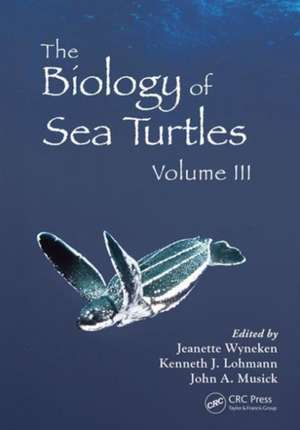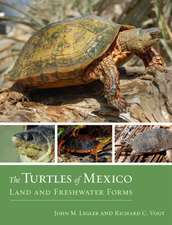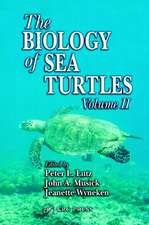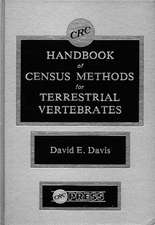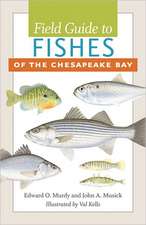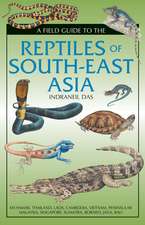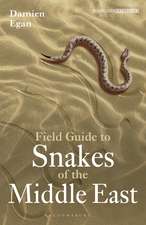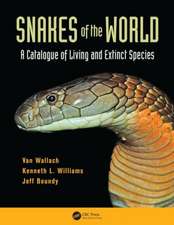The Biology of Sea Turtles, Volume III: CRC Marine Biology Series
Editat de Jeanette Wyneken, Kenneth J. Lohmann, John A. Musicken Limba Engleză Hardback – 25 mar 2013
New areas covered include in vivo imaging of structure, spatial distributions of marine turtles at sea, epibiosis, imprinting, parasitology, and climatic effects. Life history is explored in three chapters covering age determination, predator-prey interactions, and mortality from bycatch.
The Biology of Sea Turtles, Volume III will inspire scientists and students to explore and expand their understanding of these intriguing animals. The book provides clear baseline summaries, thoughtful syntheses, and effective presentation of the most fundamental topics spanning form and function, health, distributions, behavior, genetics, evolution, and ecology. Its scope and depth make it the definitive go-to reference in the field.
Din seria CRC Marine Biology Series
- 9%
 Preț: 608.33 lei
Preț: 608.33 lei -
 Preț: 389.80 lei
Preț: 389.80 lei - 9%
 Preț: 785.46 lei
Preț: 785.46 lei - 8%
 Preț: 423.12 lei
Preț: 423.12 lei - 18%
 Preț: 1373.17 lei
Preț: 1373.17 lei - 18%
 Preț: 824.43 lei
Preț: 824.43 lei -
 Preț: 442.89 lei
Preț: 442.89 lei - 15%
 Preț: 470.20 lei
Preț: 470.20 lei - 14%
 Preț: 313.87 lei
Preț: 313.87 lei - 10%
 Preț: 327.14 lei
Preț: 327.14 lei - 24%
 Preț: 430.21 lei
Preț: 430.21 lei - 18%
 Preț: 1353.68 lei
Preț: 1353.68 lei - 18%
 Preț: 798.23 lei
Preț: 798.23 lei - 18%
 Preț: 1014.77 lei
Preț: 1014.77 lei - 18%
 Preț: 1556.55 lei
Preț: 1556.55 lei - 9%
 Preț: 1246.80 lei
Preț: 1246.80 lei - 26%
 Preț: 1019.22 lei
Preț: 1019.22 lei
Preț: 700.54 lei
Preț vechi: 769.83 lei
-9% Nou
Puncte Express: 1051
Preț estimativ în valută:
134.04€ • 139.96$ • 110.94£
134.04€ • 139.96$ • 110.94£
Carte tipărită la comandă
Livrare economică 05-19 aprilie
Preluare comenzi: 021 569.72.76
Specificații
ISBN-13: 9781439873076
ISBN-10: 1439873070
Pagini: 475
Ilustrații: 98 colour illustrations, 22 black & white tables
Dimensiuni: 178 x 254 x 23 mm
Greutate: 1.04 kg
Ediția:1
Editura: CRC Press
Colecția CRC Press
Seria CRC Marine Biology Series
ISBN-10: 1439873070
Pagini: 475
Ilustrații: 98 colour illustrations, 22 black & white tables
Dimensiuni: 178 x 254 x 23 mm
Greutate: 1.04 kg
Ediția:1
Editura: CRC Press
Colecția CRC Press
Seria CRC Marine Biology Series
Public țintă
Sea turtle specialists, marine biologists, fishery scientists, biological oceanographers, zoologists, ecologists, and conservation biologists.Cuprins
Physiology as Integrated Systems. Vision. Natal Homing and Imprinting in Sea Turtles. The Skeleton: An In Vivo View of Structure. Age and Age Estimation in Sea Turtles. Molecular Genetics of Sea Turtles. Oceanic Habits and Habitats: Dermochelys coriacea. Oceanic Habits and Habitats: Caretta caretta. Feeding Biology: Advances from Field-Based Observations, Physiological Studies, and Molecular Techniques. Predators, Prey, and the Ecological Roles of Sea Turtles. Exposure to and Effects of Persistent Organic Pollutants. Fisheries Bycatch of Marine Turtles: Lessons Learned from Decades of Research and Conservation. Climate Change and Marine Turtles. Free-Ranging Sea Turtle Health. Sea Turtle Epibiosis. Parasites of Marine Turtles. Index.
Notă biografică
Jeanette Wyneken, Ph.D., is an associate professor of biological sciences at Florida Atlantic University in Boca Raton. A functional morphologist and marine conservation biologist, her studies with sea turtles have encompassed a wide range of topics, including growth, energetics, migratory behavior, feeding, sex determination, and medical imaging. She has authored more than 50 peer-reviewed papers, 9 book chapters, and 1 book, The Anatomy of Sea Turtles. She also coedited The Biology of Sea Turtles, Volume II, and The Biology of Turtles.
Kenneth J. Lohmann, Ph.D., is the Charles P. Postelle, Jr. Distinguished Professor of Biology at the University of North Carolina at Chapel Hill. His scientific interests focus on the behavior and neurobiology of marine animals, with a particular emphasis on unusual sensory systems and how animals use the Earth’s magnetic field to guide long-distance migrations. He has published research on diverse invertebrate and vertebrate animals, including more than 50 peer-reviewed studies on sea turtles.
John A. (Jack) Musick, Ph.D., is the Marshall Acuff Professor Emeritus in Marine Science at the Virginia Institute of Marine Science (VIMS), College of William and Mary. Many of Dr. Musick’s recent studies have focused on fisheries bycatch of long-lived marine animals such as sharks and sea turtles. He has published more than 150 scientific papers and coauthored or edited 21 books focused on the ecology and conservation of sharks, marine fisheries management, and sea turtle ecology.
Kenneth J. Lohmann, Ph.D., is the Charles P. Postelle, Jr. Distinguished Professor of Biology at the University of North Carolina at Chapel Hill. His scientific interests focus on the behavior and neurobiology of marine animals, with a particular emphasis on unusual sensory systems and how animals use the Earth’s magnetic field to guide long-distance migrations. He has published research on diverse invertebrate and vertebrate animals, including more than 50 peer-reviewed studies on sea turtles.
John A. (Jack) Musick, Ph.D., is the Marshall Acuff Professor Emeritus in Marine Science at the Virginia Institute of Marine Science (VIMS), College of William and Mary. Many of Dr. Musick’s recent studies have focused on fisheries bycatch of long-lived marine animals such as sharks and sea turtles. He has published more than 150 scientific papers and coauthored or edited 21 books focused on the ecology and conservation of sharks, marine fisheries management, and sea turtle ecology.
Recenzii
"It's getting better! This is not surprising considering the highly skilled team of editors and authors; the third volume of Biology of Sea Turtles should be on the shelf of every sea turtle biologist. The book is presented in 16 chapters, covering many aspects, from morphology to physiology and genetics, to organic pollutants and fisheries by catch mitigation. Previous volumes have inspired many sea turtle scientists and conservation practitioners, myself included.
…important new findings are included in this latest volume, several based on methodologies only used intensively on sea turtle ecology in recent times… Looking at the three-volume series of Biology of Sea Turtles, clear developments in the field can be seen, with a range of paradigms being revisited and revised in the last volume, for instance ontogeny and individual specialization. …
All three volumes, and the third in particular, end with recommendations for further research, the need for methodology improvements, and key questions to be addressed. This is a valuable approach, and it makes the current volume a valuable guide, as well as an inspiration, for the current and next generation of sea turtle scientists.
Overall, in my opinion the current book should be compulsory reading for researchers, managers, and conservationists who deal with marine turtles and their habitats. I cannot wait until vol. IV is available!"
—Leandro Bugoni, Universidade Federal do Rio Grande – FURG in Marine Biology Research, Volume 10, Issue 1, 2014
Praise for Previous Volumes:
" … simply cannot be missing from the bookshelf of anyone seriously involved with sea turtles, whether it be sea turtle researchers or the staff and managers of marine protected areas with sea turtles in their waters or on their beaches."
—Michael Stachowitsch, in Marine Ecology
"The Biology of Sea Turtles is one of the best places to start ... may be recommended to libraries and individuals."
—N. Mrosovsky, in Nature
" … likely to become the standard reference in the field … well illustrated with line drawings and photographs ... a first source for many herpetologists looking for current information on sea turtles."
—Kentwood D. Wells, in Copeia
" … undoubtedly a key reference text for those involved closely with sea turtle research and an essential purchase for institutional libraries … ."
—Brendan J Godley, in Marine Turtle Newsletter
…important new findings are included in this latest volume, several based on methodologies only used intensively on sea turtle ecology in recent times… Looking at the three-volume series of Biology of Sea Turtles, clear developments in the field can be seen, with a range of paradigms being revisited and revised in the last volume, for instance ontogeny and individual specialization. …
All three volumes, and the third in particular, end with recommendations for further research, the need for methodology improvements, and key questions to be addressed. This is a valuable approach, and it makes the current volume a valuable guide, as well as an inspiration, for the current and next generation of sea turtle scientists.
Overall, in my opinion the current book should be compulsory reading for researchers, managers, and conservationists who deal with marine turtles and their habitats. I cannot wait until vol. IV is available!"
—Leandro Bugoni, Universidade Federal do Rio Grande – FURG in Marine Biology Research, Volume 10, Issue 1, 2014
Praise for Previous Volumes:
" … simply cannot be missing from the bookshelf of anyone seriously involved with sea turtles, whether it be sea turtle researchers or the staff and managers of marine protected areas with sea turtles in their waters or on their beaches."
—Michael Stachowitsch, in Marine Ecology
"The Biology of Sea Turtles is one of the best places to start ... may be recommended to libraries and individuals."
—N. Mrosovsky, in Nature
" … likely to become the standard reference in the field … well illustrated with line drawings and photographs ... a first source for many herpetologists looking for current information on sea turtles."
—Kentwood D. Wells, in Copeia
" … undoubtedly a key reference text for those involved closely with sea turtle research and an essential purchase for institutional libraries … ."
—Brendan J Godley, in Marine Turtle Newsletter
Descriere
Since the first volume of The Biology of Sea Turtles was published in 1997, the field has grown and matured in ways few of the authors would have predicted. Volume III presents timely coverage of emerging areas as well as the integration of approaches and information that did not exist even a decade ago. The book assembles the foremost experts in each topic to provide the most up-to-date and comprehensive book on sea turtles available today. New areas covered include in vivo imaging of structure, spatial distributions of marine turtles at sea, epibiosis, imprinting, parasitology, and climatic effects.
